

The Folk from the Wind Wound Isle > Chapter 25 : The Descendants of Robert Robertson
page 179
Robert and Molly Robertson took their family from Port Campbell to Geelong in the 1880s so their children could avail themselves of better educational opportunities. As a result most members of this section of the family moved away from rural occupations and rural living to pursue academic professions and careers in towns and cities.

Mary and Stuart Robertson, circa 1913
Mary Rutherford ROBERTSON (1908-1990) - married name DICKINS
Eldest child and only daughter of Robert (Rab) Robertson and Fanny Daniell, born at Sandgate, Queensland on 25 March 1908.
Mary was a schoolteacher. In 1938 she was teaching at Woodside in Gippsland. This was followed by her appointment as Infant Mistress at Pakenham near Melbourne and this meant she could live at home with her parents at Ormond.
In 1945 Mary married Sidney Edmond DICKINS (1892-1964) in Mt Gambier, SA. One of the witnesses was Sid’s niece and long time business secretary Win Dickins. Sid had previously been married to Mary’s aunt, Lottie Robertson Dickins.1
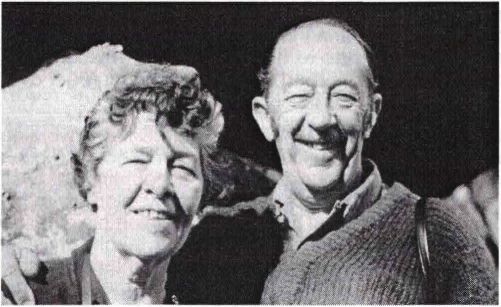
Mary and Stuart Robertson, early 1970s
Mary and Sid had one child, Richard (1950), and the family lived on a property at Vermont. Sid died in 1964. Mary died of cancer of the pancreas in 1990.
page 180
Robert Stuart Daniell ROBERTSON (1911-)
Second child and only son of Robert (Rab) Robertson and Fanny Daniell, born at Sandgate, Queensland on 21 February 1911.
Stuart’s earliest memories include the house on stilts at Sandgate, sand flats with the tide going out, and a pond with beautiful water lilies. The family left Sandgate just before the First World War and moved to Geelong to live with Rab’s parents. Stuart remembers the train trip south with his mother and sister Mary. Between Brisbane and Sydney the train stopped several times because of the amount of traffic and sailors would jump off the train and walk along looking into other carriages. Stuart would scream and make a fuss because he was frightened the sailors would be left behind when the train started again. This became a family joke.
The family stayed with Stuart’s grandparents at Barwon House until his father was called to the Elsternwick Baptist Church in about 1916. One night, while they were living in Geelong, the wool store on Corio Bay burnt down and his Uncle George took Stuart to see the remains. George drove the two-wheel jinker over one of the fire hoses and was 'told off by one of the fireman because the hose was full of water at the time and the weight of the jinker could have burst it.
After his family moved to Melbourne, Stuart started school at Caulfield Primary School and he was there for three years while the family lived at the ‘Helen’s Lea’ house. He then attended school in Sale and finished his secondary education at Melbourne High School. In 1931 Stuart became a student teacher at a school in South Caulfield, but because it was the middle of the Depression he could not get into the Teachers Training College. This left him very frustrated so in 1935 he took leave without pay from the Education Department and worked in an S E Dickins grocery store at Collingwood. After twelve months he decided the grocery business was not for him. He went back to the Education Department as a junior teacher at North Richmond and was accepted into the Teachers College in 1938. At that time students received no wages during their twelve-month course, and his sister Mary supported Stuart. When he finished he owed Mary £91 and it took him eighteen months to pay this off. As a junior teacher he received 1 pound 9 shillings and a halfpenny per week. As a trained teacher his wages went up to 9 pounds 4 shillings and 6 pence per fortnight.
As soon as Stuart had finished re-paying Mary, he and Kathleen Alison HUGHES (1912-1971) became engaged. Kay worked in the uniform section at Payne Bon Marche, a Melbourne department store, taking orders and dispatching school uniforms. The two had known each other since 1937. They were married in 1941 at St George’s Presbyterian Church, East St Kilda by Stuart's father Rab Robertson. The best man was Henry Volk.2
Stuart and Kay have four children, Craig (1944), Lee (1947), Peter (1949), and Sue (1951).
Stuart spent the years 1939-41 as a physical education teacher. In 1941 he joined the AIF and spent two and a half years as an anti-aircraft gunner, attaining the rank of Lieutenant. He then transferred to the RAAF and spent a further two and a half years in Airfield Defence. He saw active service in the Pacific rising to the rank of Flying Officer. RAAF service men like Stuart, who did not fly, were known as ‘Penguins’. Stuart’s discharge from the RAAF at the end of hostilities was delayed because it was discovered he had a severe hearing loss and the authorities wanted to decide, before they discharged him, whether this was due to his war service. Repatriation eventually accepted that the hearing loss was war caused. Stuart has worn a hearing aid ever since leaving the Airforce.
Stuart continued his career as a physical education teacher at Melbourne High School, working half time while he upgraded his qualifications through the Commonwealth Reconstruction Training Scheme. He studied commercial law, economic geography and accounting, as well as undertaking a physical education course at Melbourne University. This study, along with his war service, qualified him for his teaching Honours Certificate. The cost of obtaining his diploma was 10 guineas but as he didn’t have the money he never collected it. Stuart taught physical education at Melbourne High School for eighteen years. In 1967 he was appointed Principal of Boorondara North, a new primary school in the Box Hill district. He remained there until his retirement in 1976.
Sadly Kay died of a massive heart attack in 1971. The couple was out shopping in a self-service store in Chapel St and Kay went off to check out some item or other. She did not come back and when Stuart went to search for her, he found her on the floor in one of the aisles with a member of the staff trying to give her resuscitation. She was taken to the Alfred Hospital but pronounced
page 181
dead on arrival. Stuart gives us a picture of her as a beautiful and fun loving person, “I thought the sun shone out of her.”4
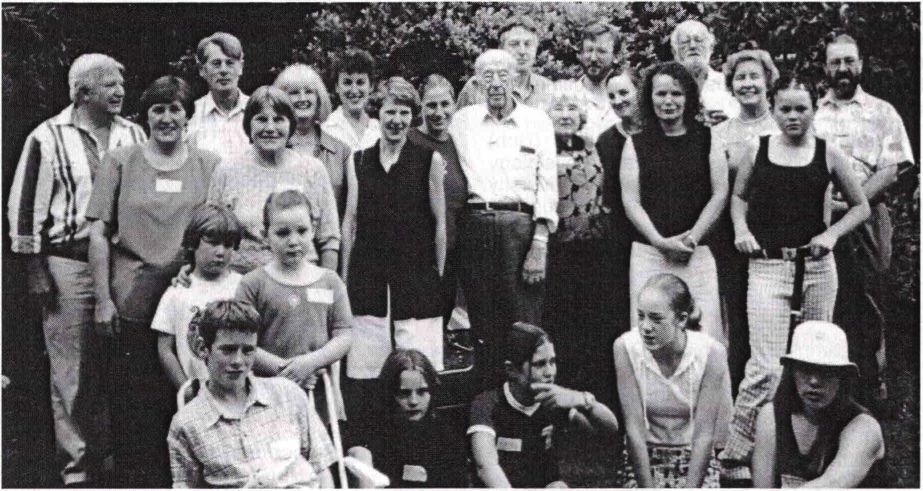
Descendants of Robert Robertson, Melbourne 2000 Left to right standing: Max Chapman, Sue , Peter and Lucy Robertson, Bobbie Chapman, Jane Robertson, Lee and Jane O'Keefe, Stuart, Craig, Pixie and Tim Robertson, Sally Wadham, Jennifer Williams, Rod Robertson, Ailsa McLennan, Belinda Williams, Richard Dickins. Left to right in front: Felix Watson, Arthur, Harriet, Laura, Katie, Danielle and Stephanie Robertson.
Throughout his life Stuart has had a love of boats and motorcars but he has rarely had the money to indulge his passion. As a child he made his first boat out of a sheet of tin used for the family’s chook house. His grandfather gave him £1 to buy the piece of corrugated iron, which had to be flattened out before it could be used for a boat. Several people have told me about his adventures with cars including a lucky escape when a truck hit him. Stuart was all right but the Mazda RX7 he was driving was demolished. At the age of eighty-nine, Stuart was driving a Mazda MX6.
Rutherford Ness (Bob) ROBERTSON (1913-2001)
Only child of Joshua Robertson and Josie Hogan, born in Melbourne on 29 September 1913. His names come from the maiden names of his paternal grandmother’s mother (Margaret Rutherford) and his maternal grandmother (Anna Maria Ness). Within the family he was called Routh, outside the family he is known as Bob.
At the age of five Routh developed poliomyelitis. He attributed his good recovery to the therapy and exercise administered by his mother and her determination to get him mobile.
Routh remembers visiting his Great Uncle Arthur Robertson and his second wife, at Port Campbell, on a number of occasions between the ages of six and twelve. Here he was taken under the wing of Arthur’s grandson, Arthur Ward, who was eight years older than Routh. He would accompany young Arthur in the spring cart when Arthur took the milk cans to the butter factory. On one occasion Arthur stopped to talk to a farming friend. Routh, whose knowledge about sex was limited at the time, was mystified by their conversation which included the comment ‘we had better get to that bull and cut it because it’s starting to be troublesome’. Plans were made for doing this. Routh asked Arthur what ‘cutting the bull’ meant. Arthur became embarrassed and told Routh he had better ask his father. Routh did ask Josh but got little extra information, simply being told that they cut the bulls private parts so he would not interfere with the cows. “Such was typical of what they thought was allowable for children to know then!’’5
page 182

Rutherford Robertson with his father Josh in 1914
On another occasion at Port Campbell, where the coast was notorious for shipwrecks, a sheep fell over a steep cliff. Arthur Robertson asked Josh to help him rescue the sheep. Rutherford was terrified his father would fall over the cliff and never come back.
Rutherford commenced school at Carey Grammar School in Melbourne in the first year of that school’s operation. He completed his schooling at St Andrew’s College in Christchurch, New Zealand after his father was transferred to NZ in 1926. The following piece from the University of Sydney, Faculty of Science, Hall of Fame outlines his professional career: 5
“Professor Sir Rutherford (Bob) Robertson’s interest in plant physiology began in his honours year at the University of Sydney (1933) and continued throughout a distinguished career which saw him receive scholarships, degrees (PhD, DSc), medals, appointments (Australia and overseas), and awards (including AC, CMG, and 4 doctorates honoris causa).
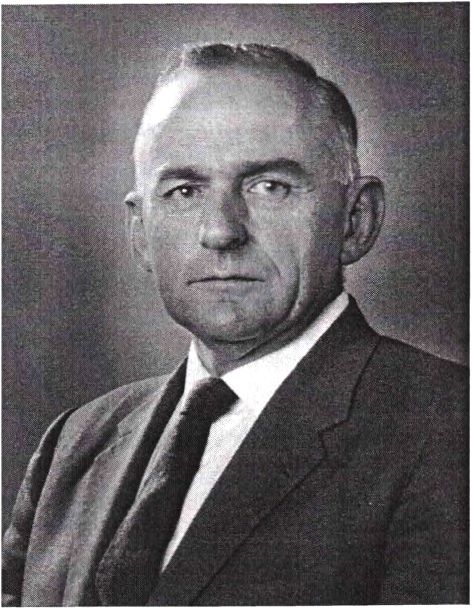
Rutherford Robertson in his 50s
Reproduced with the kind permission of the Faculty of Science“On completion of his PhD at Cambridge (1939) Bob returned to Australia to the University of Sydney as Assistant Lecturer in Botany. When war broke out with Australia unable to export its wheat and fruit crops, research turned to food storage. Bob worked on the physiology of stacks of wheat and, with scientists at CSIR (now CSIRO), on the physiology of apple fruits in storage.
“After the war Bob joined the CSIR in charge of the Plant Physiology and Storage Section and subsequently combined this section with the plant physiologists in the Botany Department to form the Plant Physiology Unit at this University. Being among the first to establish the connections between respiration, the flow of protons, the absorption of ions and the phosphorylations which distribute energy, he achieved international recognition and published a definitive book. He was elected Fellow of the Australian Academy of Science (1954), of the Royal Society of London (1961) and Foreign Associate of the US Academy of Science (1962).
“Although his major loves were in research and teaching, he agreed to become an administrative member of the CSIRO Executive for a limited term. He returned to his main interests by accepting the Chair of Botany at the University of Adelaide. After 7 years he was appointed Master of University House, ANU, with time for
page 183
research, but finished his formal working life as Director of the ANU Research School of Biological Sciences in 1978.
“Bob served on many committees. When the Government decided to allocate money for research in universities, he was asked to establish what became the ARGC (now ARC). He chaired the committee for 4 years and instituted a process for the competitive distribution of the funds.
“He served as President of the Australian Academy of Science (1970-74). At that time science and technology had not achieved the recognition they now receive, and the Academy spent time in bringing their vital significance to the notice of decision makers in government, bureaucracies, industry and not least, the ABC.
“After retirement, Bob continued both research and committee work, including terms as Pro-Chancellor of ANU and as first Deputy Chairman of ASTEC.
“His lasting contributions to science are his own research, his influence over several generations of students and research workers, and his public roles as an advocate for and communicator of science.”
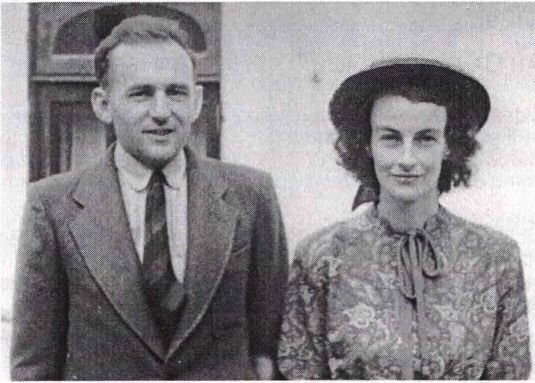
Rutherford Robertson and Mary Rogerson Robertson
In recognition of his work Rutherford was granted a knighthood in 1972 and in 1980 he was made a Companion of the Order of Australia (AC). For his work in connection with the Australian Research Grants Committee he was made a Companion of the Order of St Michael and St George (CMG).
Bob married Mary ROGERSON (1915-2001), the daughter of George Thomas Rogerson, who was born in Wamphray, Scotland and came to Australia in 1910. George initially worked as a jackeroo. Mary’s mother, Jean Morrison McTavish, was born in Lockerbie, Scotland. She came to Australia in 1912 and married George Rogerson in Melbourne. The couple took up land in Gundaroo NSW, where Mary was born. In 1921 George bought better land at Binalong, NSW. The property there is still owned by the family and provides a great place for family holidays and get-togethers.
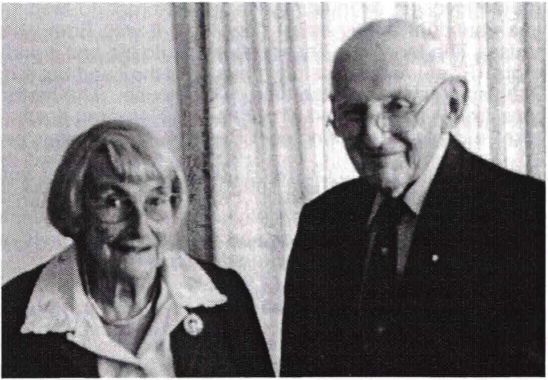
Mary and Rutherford Robertson, 1997
Mary graduated with a BSc in Botany and Geology, and she and Bob became engaged in 1936, before Bob left to study at Cambridge, UK. Mary joined him in 1937 and they were married at All Saints’ Church, Cambridge on 9 September 1937. They have one son, Rob (1944), born after the couple returned to Australia. Mary did not study at Cambridge but helped Bob with his PhD. When they came back to Australia Mary was involved in part-time demonstrating in Botany at Sydney University and school science teaching.
When they were courting Bob and Mary were getting ready to attend the wedding of an Anglican friend, “Hope they don’t forget the champagne” said Mary. This had Bob’s Baptist parents wondering ‘what sort of girl he was going out with’.6
page 184
The marriage worked out well and in 1997 Mary and Bob celebrated their diamond wedding anniversary. An article celebrating this event was published in the Yass Tribune on 24 September 1997. Technically retired, the couple lived their final years in the Linton Retirement Village in Yass. However Bob involvement in scientific projects continued right up till a few weeks before his death on 5 March 2001. Six weeks later, Mary was involved in a car accident and although her injuries were not serious she suffered a cardiac arrest and died on 21 April 2001.
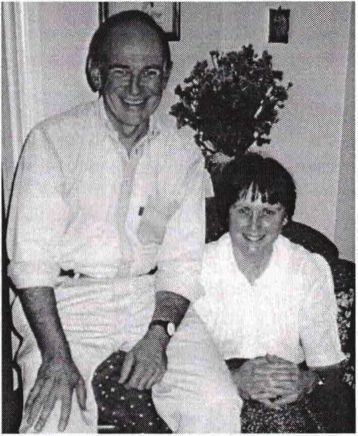
Rob and Jan Robertson, 2000. Rob is Mary and Rutherford’s son.
Rutherford recorded two tapes for the Academy of Science about his professional work. There are several newspaper articles and obituaries and with an entry in ‘Who’s Who in the World’ on Rutherford. 7 Appendix 5 contains a poem Robert Robertson Snr wrote for Rutherford in 1935, to celebrate Routh’s work on leaf structure.
Ian Campbell ROBERTSON (1915-1995)
Eldest child of Arthur Robertson and Clare Campbell born at Geelong on 16 September 1915. 8 At first Ian’s parents called him Cam, but when his mother was confined with her second child, fifteen-year-old Nancy Cutlack looked after Ian and she preferred to call him Ian. When he came home and his parents called him Cam he said ‘I not Cam - I Ian’. So Ian he remained. 9
Ian started his schooling at Renmark in South Australia, continuing at Ballidu WA when the family moved there to live on a farm called ‘Wenscote Barton’. Returning home one evening on his horse Ginger, Ian took a short cut and ran straight into a single line of barbed wire, which a neighbour had stretched across the track to stop cattle straying. The horse was badly torn and Ian came a cropper and sustained a broken collarbone.
Ian’s education continued at the Perth Boys School where he matriculated in 1933. During this period the family lived at Bayswater near the Swan River. Ian, his good mate Harry Evans and another schoolmate Brendon, had equal shares in an old decrepit Douglas motor cycle (flat twin and belt driven). A noisy contraption that took up all their spare time. Petrol was precious and they had to save to buy it a bottleful at a time. The motorbike had no brakes and getting it started involved strenuous pushing, “whereas to stop it meant running it into the soft sand that was abundant in the area. [One day] it was Brendon’s turn to be pushed down towards the house. The fearsome beast bellowed into life and it and Brendon disappeared at a great rate of knots. Brendon desperately turned into the sand but forgot to close the throttle, both he and the Douglas crashing into the side of the house. The motor stopped [and] Brendon fell back semiconscious on the ground while Ian and Harry ran down shouting ‘the juice, the juice, turn off the juice!’ completely ignoring poor Brendon, the precious petrol had to be saved!”10
The family had an old Overland utility. Ian and Harry would sit in it, Ian playing the mouth organ, the two of them bragging about the girls they met at dances at the Perth Town Hall and how they were going to offer to drive them home. This never eventuated, for apart from the boy’s shyness, the utility had no mudguards and no lights and always had to be home before dark. Eventually the Ute was sold to the wreckers for £5.
page 185
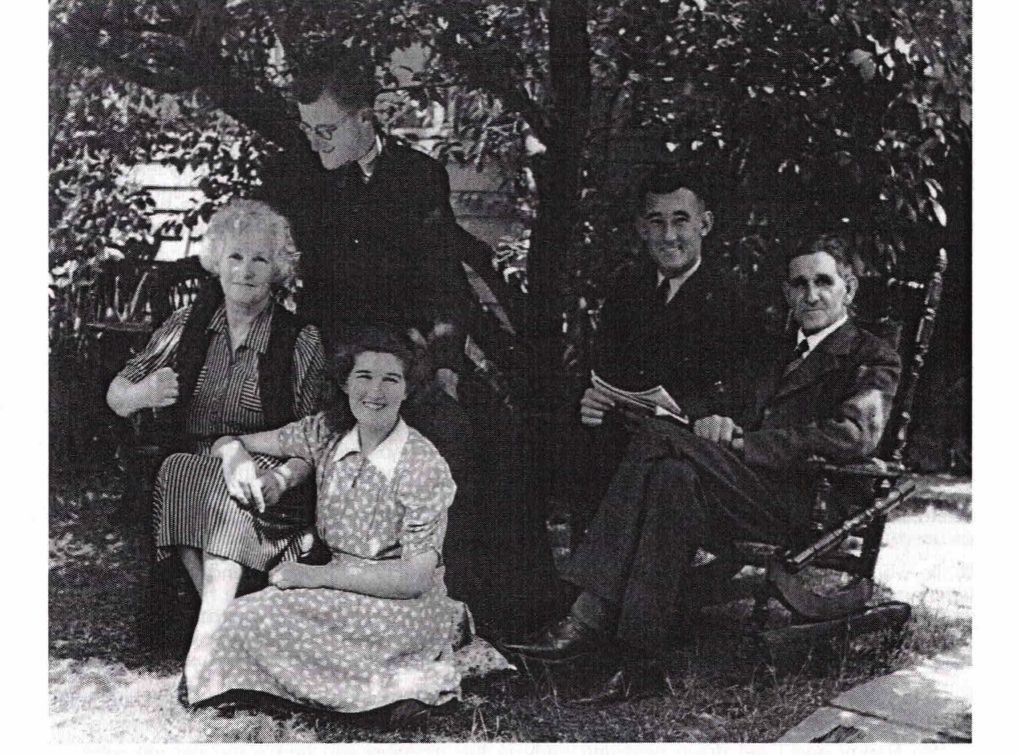
Arthur Robertson Family, 1944. Left to right: Clare, Rod, Pixie, Ian and Arthur Robertson.
Leaving school Ian went to ‘Minnie Creek Station’ near Carnarvon as a jackeroo. The country was in the grip of both the Depression and a four-year drought, so it was not a good time for anyone. While he was away Ian and his sister Pixie corresponded in French.
When the rest of the family moved to Melbourne Ian joined them and had short-term jobs with Dickins grocery and the Austin car distributors before joining the RAAF in January 1938. His Airforce record tell us that at the age of twenty-two Ian was just under 6 feet tall, weighed 150 pounds, and had brown hair and eyes. His interest was in mechanical engineering and he undertook a number of training courses while serving with the RAAF. When the war came Ian saw service in Australia and the Pacific (Morotai). He continued in the RAAF for three years after the end of hostilities and a comment by a senior officer in 1947, when Ian was stationed at Point Cook, states: “F/O Robertson has a sound knowledge of Service Transport and his ability and enthusiasm leaves nothing to be desired. He is keen and keeps abreast of all matters in connection with his work. He is popular with his fellow officers and takes an interest in station affairs.”11 Ian rose to the rank of Flight Lieutenant before leaving the Airforce in March 1948.
After his discharge, Ian established his own engineering business at Arthur's seat on the Mornington Peninsula. He drove in two Redex Round Australia Trials, finishing well in both. Joining the staff of the RACV he established the RACV Driving School. He also started the miniature road course at Kew, designed to teach children road sense. Ian was an enthusiastic yachtsman, enjoyed sailing on Port Phillip Bay, and was a member of the Coast Guard Patrol.
In 1954 Ian married Tamara RIMSHA (1921- ). The best man was Harry Evans and Pixie Robertson was the bridesmaid. Ian and Tamara’s only child, Sabina, was born the following year. Ian died in 1995 after a long illness. His lifelong friend Harry Evans presented the eulogy at his funeral.
page 186
Louise Coralie Campbell (Pixie) ROBERTSON (1917-)
Middle child and only daughter of Arthur Robertson and Clare Campbell, born at Renmark, South Australia on 31 October 1917. Known as Pixie.
When the family lived in Perth in the 1930s, Pixie learnt music from Sister Terese at a convent in West Perth. Pixie’s father had obtained a copy of the music from ‘Choo Chin Chow’ and when the film version came to Perth, Pixie and a friend asked Sister Terese if they could miss their weekly lesson so they could go to see the musical. Permission was granted. Next week however they found Sister Terese very distressed because one of the other nuns had told her the girls would be sitting in the dark. Seems Sister Terese had never been to the cinema and who knows what might have happened in the darkness! 12
Pixie qualified for her matriculation in WA in 1936. She studied science at the Royal Melbourne Institute of Technology, followed by specialized nursing and hospital technology work. At the final exam for Psychiatric Nursing in 1942, Pixie topped the State. From 1943 to 1945, Pixie was Matron at the Travancore Centre for Disturbed Children. She then spent two years in charge of the Intravenous Solutions Laboratory at the Alfred Hospital in Melbourne, followed by two years in a similar position at the Brisbane General Hospital.
In 1951 Pixie commenced training in Biochemistry at the Repatriation Hospital in Melbourne, followed by further training in Haematology, Bacteriology and Biochemistry. She was a foundation member of the education committee to draw up syllabus for the formal education of medical technologists. For five years from 1955, she was in charge of the Solutions and Bacteriology Laboratories for the Red Cross Transfusion Service. This was followed by a year as assistant in the London University Medical School’s Biochemistry Laboratory.
While working at the London Medical School in 1961, Pixie visited Shetland in her summer holidays, accompanied by Nancy Basey, her brother Rod’s mother-in-law. They spent two weeks there. She tells us that Nan was well received but a comment was made to her that ‘Shetlanders who go away and come back are frowned upon’. Apparently her appearance led people to believe she was Shetland born. She had to explain she was born in Australia.
Pixie and Nanny Basey decided to hire a car. The man they hired it from said he would leave the car in the square with the keys in it, and they could pick it up whenever they liked.
“So Nanny and I get down nice and early in the morning and here’s the car we were looking for sitting in the square with the key in the ignition. We had a lovely day. [At one place a man said,]
‘I see you’ve got the Major’s car'.
‘We didn’t know it was the Major’s, we hired it’.
‘I don’t think the Major would put his car out for hire’.”
What they had done was take the wrong car, but in the end no one seemed to mind and everyone had a good laugh. 13
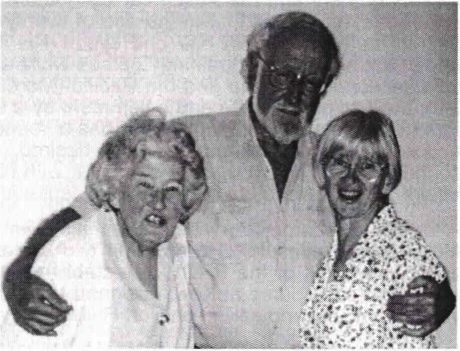
Pixie and Rod Robertson With Margaret Worrall, Melbourne, 2000
From 1963 to 1982, Pixie was supervisor of the Sterilizing Department at the Royal Children’s Hospital, Melbourne, and in 1971 she became a member of a team that made annual visits to country hospitals throughout Victoria to inspect facilities and advise on sterilization. She has served as Treasurer of the Australian Medical Technologists Association, Secretary of the Sterilization and Disinfection Society of Victoria and in 1982 she was made a life member of that society.
She has lectured and been an examiner for ‘Methods and Management of Sterilization in Hospitals’. In 1971 Pixie was made a life Governor of the Royal Children's Hospital
page 187
From October 1973 to March 1974, Pixie worked for the World Health Organization advising on sterilization and disinfection at the Medical Teaching University in Baghdad. And somewhere in between all of this Pixie has found time to be a member of Soroptimist International.
Pixie is an inveterate traveller to out of the way places. She has been up the Amazon in an open wooden boat, when going to the toilet meant hanging out over the rear of the boat. She has sailed up the Nile and made three visits to Antarctica - once on the icebreaker ‘Lindblad Explorer’ and twice by plane. During a flight in a ropey old plane to Lake Titicaca in Peru, a piece of her seat fell off into the aisle, but this caused little interest as it was not seen as anything unusual. She has an immense collection of photographs she has taken on her travels.
Pixie has not married and in retirement she lives in a nice little flat in South Yarra, Victoria.
Roderick Campbell ROBERTSON (1926-)
Youngest child and second son of Arthur Robertson and Clare Campbell, born at Renmark, South Australia on 1 May 1926.
The family was living on the farm at Ballidu in Western Australia when Rod was about three years old. One day at harvest time, Rod wandered off “with the dog I regarded as my own - a huge kangaroo dog, which towered over me, and I called Pup”. He wheeled along his only toy, a device his brother Ian had made for him from a length of twisted fencing wire attached to an old tyreless pram wheel. When it was realized the toddler was missing all work stopped and everyone, set out to look for Rod. Among the workers was a black tracker who traced Rod through the wheat field, onto hard ground and to a dam where Rod stood contemplating the water. When told that he had been lost Rod was perplexed, “I wasn’t lost, I was with Pup”.14
Rod did not start school till he was seven. He was however having piano lessons from Sister Terese at the convent in West Perth where Pixie also learnt music. Sister Terese suggested to Clare that as Rod was already coming to the convent for music it would be sensible for him to also attend the convent school. Now Clare was strict Church of England but she went along with the practicality of this idea, so Rod started at the convent. When he came home after his first day Clare asked Rod how he had got on. He replied it had been good but that he needed three pence. Clare wanted to know why he needed three pence and Rod replied it was to buy 'Rosemary beads’. Rod did not go back to the convent school!
One of the interesting things about Rod is his ability to remember events in association with the cars people had at the time. He says, “I have a fantastic memory for cars ... the year, the model, the make, two-door, four-door, or anything else”.15 He tells a story about one of his early car experiences. Every Saturday morning when the family lived at Camberwell, Rod rode over to Normanby Rd, Kew on his Malvern Star bicycle, to have a violin lesson with Mr W A Bennett.16 He did not take his violin for lessons as he used one of the many instruments Mr Bennett’s owned, however, he carried his music books in a big leather bag slung across his body by a long strap. On this particular day as he was turning right into Normanby Rd from Cotham Rd, he was hit from behind by a car and sent flying. “I went right over the car and as it passed beneath me I couldn’t help noticing it was a dark green Morris 8/40 with a sunroof, 1938 model.” Rod ended up winded, lying in the middle of the tram track. Fortunately an approaching tram stopped but the driver wanted to get on with his journey so Rod was rolled into the gutter. “I was gasping for breath. This bloke ... stopped the Morris 8/40 and walked back and said, 'How are you feeling. ‘I said ‘Great!’ He said ‘I’m going up to the shops in Glenferrie Rd and if you’re still here when I come back I’ll run you home’.” Someone got in touch with Rod’s Dad and he came down looking for the driver who had knocked his son down and then driven off - ‘Where is he, where is the bugger, I’ll kill him.’ Rod still has the Malvern Star!17
In 1942 Ian was with the RAAF in Darwin and showing extraordinary confidence in his sixteen year old brother, he asked Rod to buy him an MG motorcar. Off went Rod on his Malvern Star to inspect MGs that were advertised. He “located a beauty - 6 cylinder MG Magnette at a lovely home in Kooyong Rd [Caulfield], A test drive and negotiation on the asking price with the vendor ... resulted in an agreed purchase price of some hundreds of pounds and a deposit paid.” 18 Rod
page 188
then got on his bike and rode home. Ian sent the money down from Darwin and Rod did some more negotiating, getting a £10 reduction on the price because the spare wheel was missing.
Rod completed his schooling at Camberwell Grammar School. When he turned eighteen in 1944 he enlisted in the Airforce, anxious to join his brother. He had barely completed his training and been posted to an Operational Training unit when peace was declared - somewhat to Rod’s relief he tells me!
At Melbourne University Rod studied piano and violin. He then went to Europe to undertake post-graduate studies. Apparently not much studying was done, but he did propose to Lucy Basey under the Peter Pan statue in Kensington Gardens. Lucy accepted and the pair set about raising money to pay for the journey home. They had grand plans of buying a used car and driving back to Australia but this came to nothing. Finally they scraped up enough for their fares by ship and during the voyage Rod held an auction in his cabin of his last meagre possessions. With the money raised he was able to buy Lucy a white sapphire engagement ring “of very questionable quality” when they reached Ceylon.
Rod and Lucy BASEY (1928-) were married at St John's Church, Toorak in 1956. As explained in an earlier section, Lucy and Rod’s families had been friendly for many years. When Lucy was born Rod’s mother lent Mrs Basey Rod’s crib for her new baby. Rod and Lucy had a house built “high on a hill in leafy Eltham”. It was finished just in time for the arrival of twins, Jane and Tim, in 1958. Benjamin followed six years later.
Rod has two passions in life, music and motorcars. He still has the MG that he raced for many years with some degree of success, being an ex-Road Racing Champion of the MG Club and holding records in Historic Racing events.19 His three children were his pit crew during the early days of Historic Racing. Having driven with Rod I can attest to his propensity for going through yellow lights and his ability to get you from here to there in a hurry!
With his double love of cars and music it is hardly surprising that Rod lists his occupation as automotive buyer and musician. These loves have carried over to Rod and Lucy’s three children. All three are gifted musicians with Jane (classical clarinet) and Ben (jazz double bass and composer) working as professional musicians. Tim is an arranger, plays guitar and piano and sings in acappella groups.
William Harlock Gladstone ROBERTSON (1915-1978)
The younger of Glady Robertson and Alice Harlock’s two sons, born at Geelong on 9 September 1915. Known as Lock or Locky.20
During World War II, Locky served in the RAAF, his son describes him as “an Errol Flynn look alike ... with a rather rakish air”. Locky met Marie Jean VINCENT (1920-1999) in 1941 and the two were married in October of that year at St Andrew’s, Cronulla. Bill refers to his mother as Ethel, so I assume this was the name she was known by. She was the youngest child of Ethel and Ernest Vincent who lived at Cronulla in NSW and she started her working life in 1938 as a clerk with Qantas.
The couple’s first child William (known as Bill) was born in 1943. After Locky was demobbed from the Airforce in September 1945, he and Ethel lived in both Melbourne and Geelong. They then moved to Mildura to “pursue my father’s obsession for owning a fruit block". They lived in rented rooms before moving into their first ‘home’, a small weatherboard and corrugated iron cottage in Pine Ave, Mildura, with internal walls of whitewashed hessian and paper. It was while they were living here that their second child, Shan Marie, was born in 1946.
Round about 1948, the family moved to a more substantial home in Walnut Ave near the railway line. Bill mentions cattle being driven through the streets by drovers and their dogs on their way to the cattle yards, and “Hindu tinkers and knife sharpeners [who] cadged billies of water from the rainwater tanks in the back yard. ... Ration cards were still in use and the milk, the ice and the vegetables were all purchased at home from men [with] horses and carts.” The Robertson house was known as The Cattle Yard Inn’ or ‘Robbie’s Rubbidy’. Each day Locky rode his
page 189
bike out to the Merbein Winery [where he presumably worked]. As well as work, life included ‘entertaining, clubbing, golf, fishing, picnics, reading and child raising’
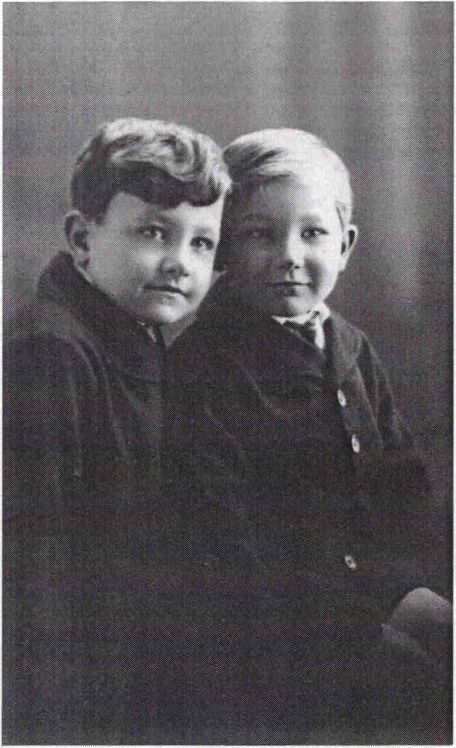
Rad and Locky Robertson. Locky is on the right.
In 1950 Locky was able to realize his dream and purchased a block of land at Red Cliffs, just south of Mildura. The period between 1950 and 1969 was one of “hard work, sand and dust, storms and frost ... complicated by fluctuating world dried fruit markets, changing bank policies and the politics of dried fruit production and processing. Life seemed little more than an endless stream of scratching out a living. The heat and flies, with initially no electricity, no car and a one and a half mile walk to town.” However the family found time to join in and enjoy local activities and the social life associated with the school etc.
Bill suggests it was during this period that his parents got pretty serious about “knocking back unending quantities of Muscat and water and ice while incessantly smoking and chewing Veginen.” This would eventually have a serious effect on their health and in later life Ethel suffered from emphysema.
Bill pays a compliment to his mother’s cooking and her hard work on the farm. Morning and afternoon every day of the three or four weeks as the crop was lifted she provided “for pickers down the block, hot and sticky from their toils, a four gallon drum of fresh water, a towel and a huge pile of freshly cut sandwiches, or newly baked scones or fruit loaf accompanied by a gallon of hot tea. Although none of this was mandatory, this was the standard Eth and the Old Man developed for themselves and to which they adhered religiously for nearly thirty years.”
Locky suffered from spondylitis and gradually his back deteriorated so that he could no longer do work on the farm. He and Ethel moved back to Mildura. “By previous standards their lives became sedentary: television, gardening, shopping, driving holidays, reading, a little fishing, and by then, grandchildren.”
Locky died in 1978 at the age of sixty-three. Ethel moved to Cronulla where she had grown up. Here she made new friends and joined in various activities. In 1988 daughter Shan Marie died unexpectedly and this was a difficult time for Ethel. Her health deteriorated over the next few years and in 1998 she moved to a nursing home, “though she was physically incapacitated, her mind was a sharp and cutting as ever”. Ethel died in 1999.
Apparently Ethel was prone to getting her words back to front and Bill finishes his loving celebration of his mother’s life by giving us some examples. “Sounds like a head with its chook cut off.” “Stoking their pinking noses in.” “Clawing at nothing that’s there.” “There must be someone looking at the window through me.”
page 190
James MacGregor DICKINS (1923-)
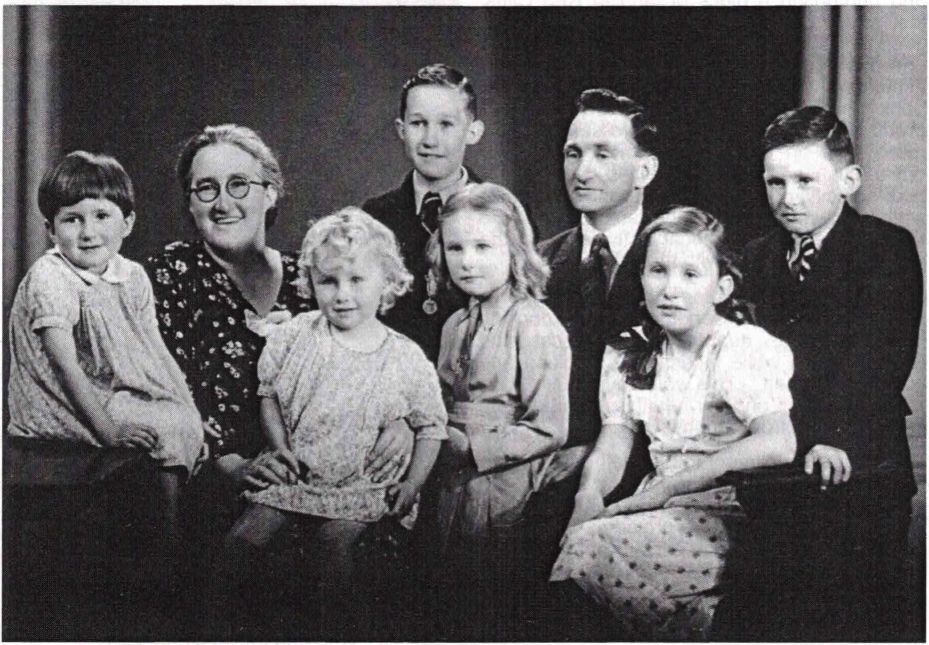
Dickins family, 1937 Left to right: Barbara, Lottie, Margaret, Mac, Marie, Sid, Joy, Neil.
Eldest child of Charlotte Robertson and Sid Dickins, born at Geelong on 7 September 1923. He was named after a friend of his father’s who was killed during the First World War. Always known as Mac.
Mac started school at Geelong College and was there until 1933 when financial difficulties during the Depression, forced his parents to take their children away from private schools and send them to the North Shore State School. After the family moved to Melbourne in 1937, Mac attended Melbourne High School. Out of school hours he worked in the Glenferrie Dickins shop, weighing and packing goods. At school he concentrated on economics, but deciding to pursue his interest in geology he did an extra year, so he could matriculate in science.
The war was in progress and as soon as he turned eighteen, Mac received his call up for the Army. He served in the CMF until the beginning of 1944, and then transferred to an AIF tank attack regiment as a gunner. He served in New Guinea. When Mac come home on leave from New Guinea, his younger sisters Barbara and Margaret, returning from school, would know he was in the house because the smell of his jungle greens was so pervasive. He would try to trick them by hiding, but they soon tracked him down following that smell.
Returning to civilian life in 1946, Mac was able to study science at Melbourne University with the assistance of the ex-servicemen’s repatriation scheme. In 1948 he joined the Australian Bureau of Mineral Resources as a Cadet Geologist, his area of expertise being palaeontology. At first he worked in the Department’s Melbourne branch, but was later transferred to Canberra.
Mac married Gwenneth EDWARDS (1925-) in June 1947. Gwen, who is the daughter of Percy Edwards and Bessie Young, lived not far away from the Dickins family in Kew, and had attended Swinburne Technical College with Mac’s sister Joy. Mac and Gwen have three children, Greg (1949, also known as Charlie), Lyn (1951) and Clive (1954).
In 1951 the family moved to Canberra. Except for a year in Brisbane in 1958, when Mac completed his, PhD at the University of Queensland, Mac and Gwen have lived in the same house in Bent St, Turner, since 1951. Two years after moving to Canberra, Mac lost most of his research material in a fire which destroyed the Bureau’s offices in Civic. The story goes that
page 191
when Mac eventually submitted his thesis for assessment, the university wrote to an English university inquiring about the best person to assess the topic Mac had chosen. The answer came back that the world authority on that particular topic was J Mac G Dickins!
After he returned from the war, Mac joined the Australian Communist Party. His involvement drew the whole family into the area of left-wing politics although none of his siblings joined the party. The family experienced an anxious time when the Menzies Government tried to outlaw the Communist party in 1951 and for a time it seemed Mac might be sacked from BMR because of his party membership.
Throughout his life Mac has continued his interest in social issues and the betterment of society - serving on local committees, coaching a junior football team, and membership of the Humanist Society. He served for sixteen years as Chairman of the ACT division of the Professional Officers Association and is a life member of the Commonwealth Public Service Union. He has also served as Secretary of Geological Society of Australia and was on the committee of the Association of Australasian Palaeontologists. His work has taken him to every continent except Antarctica. He has had a number of fossils named after him including a whole genus of Russian Gastropods (sea snails) of the Permian period (Dickinsella). These fossils are 250-290 million years old - Mac says they are old codgers like he is! Mac has made two tapes giving an account of his life in Canberra and work with the BMR (now known as the Geoscience Australia). These are held by the oral history section of the Australian National Library.
Mac must be one of the most prolific postcard senders of all time, for wherever he goes, family members can be sure of receiving a card. Whether they can read Mac’s writing on the back of the card is another matter!
Gwen worked for many years at the Australian National Library in Canberra. Her Sunday night family dinners are wonderful events where you will meet up with whichever relations happen to be in town.
Although he is technically retired, Mac just keeps working away at his science and continues his involvement in community activities, acting as Convener of a Coordinating Group for some forty organizations concerned with environmental and planning issues in the ACT.
Mac has always been a keen gardener and I have been fascinated to find beans, tomatoes or other vegetables growing amongst the flowers and shrubs in his garden. One time I asked Mac what he wanted to be remembered for and his response after much thought was, “For growing good broad beans.”
Sydney Joy DICKINS (1925-) - married name STEWART
Second child and eldest daughter of Charlotte Robertson and Sid Dickins, born at Geelong on 14 March 1925. Her name was given to her because she was her father’s joy and Joy is the name she is known by.21
Joy started school at Morongo Presbyterian Ladies College in Geelong, but like Mac, she was moved to the State School during the Depression. She showed an early interest in art and her mother encouraged this. After the family moved to Melbourne, Joy attended Swinburne Technical College where she studied art. This was followed by three years at the National Gallery Art School where she was trained by, and mixed with, many well-known artists. To help support herself, Joy worked as assistant to the pottery teacher at Swinburne and did baby sitting while she was at the National Gallery.
The Australian Book Society was formed in the 1950s, with the aim of encouraging the publication of Australian writers. Joy was a member of the Board of Management. Apart from attending board meetings, her role involved door knocking and enrolling new members, and she arranged social functions with writers such as Frank Hardy, Judah Waten, Alan Marshall and Alan Morrison, as the guest speakers. These functions were often held in the Dickins’ family home.
Leaving art school, Joy’s first job was as a doctor’s receptionist. This was followed in 1949, by a position as display artist at the Museum of Applied Science in Melbourne. “The work expected
page 192
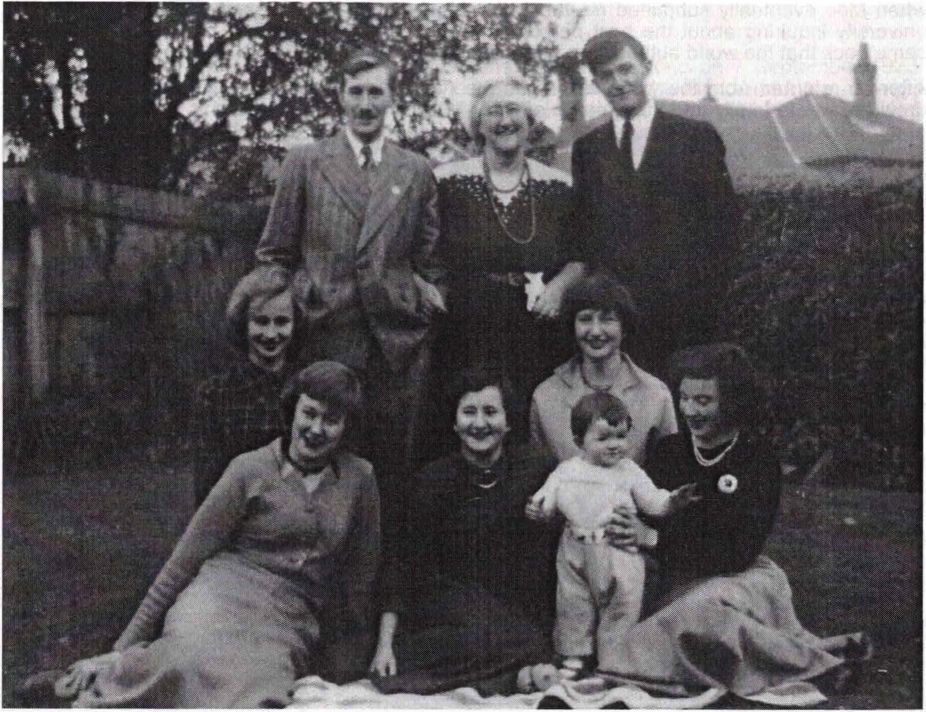
Dickins family, 1950. Left to right, standing: Mac, Lottie, Neil. Kneeling, Margaret, Joy. Sitting: Marie, Barbara, Greg, Gwen (Mac’s wife and child).
of me included the modelling and casting in wax, of exhibits such as fruit, plants and vegetables. Then I coloured them to a natural appearance. I also arranged displays in showcases and painted background scenery and props, did designs and lettering on showcases.” 22
Also working at the Museum was Bill STEWART (1922- ) whom Joy married in 1952. The marriage was dissolved in 1959. Under the Public Service regulations of the time, women were forced to resign when they married. Joy was allowed to continue until a replacement could be found, but as a matter of principle she refused to train someone to take her place. Joy left the Museum in December and Bill resigned soon after.
For a while Joy toyed with the idea of setting up a commercial pottery, but had neither the money nor the site for doing so. The couple decided to head north. They stopped in Newcastle for six months and Bill obtained work in an electric light globe factory. Joy made artefacts, which she hoped would sell, and painted churches, historic cottages and buildings. Architecture and old buildings became an abiding interest and many of the building’s Joy has painted over the years are now demolished.
Returning to Melbourne Joy worked for Guy Boyd Pottery where she created designs which she then painted or incised onto articles before they were fired. She was paid ‘piece work’. Joy specialized in Aboriginal designs and these sold well. It was during this period that Joy and Bill’s marriage broke up and Joy moved back to the Dickins house in Barker’s Rd.
In 1954 Joy applied for and obtained the position of Table-setting Consultant at the Myer Store in the city of Melbourne. She held this position until 1967. Attached to the Display Department, her job involved setting up table displays of china, cutlery and glassware, along with the flowers and decorations to go with them. Later her responsibilities extended to the manchester and furniture departments. Special displays would be arranged for Christmas, Mother’s Day, Easter and so
page 193
on, and there were promotional displays for particular manufacturers. The workload gradually expanded and an assistant was appointed to help her.
By 1967 Lottie’s health was deteriorating and she needed someone to be at home to watch over her. Sid had died in 1964 and left each of his children some money, so Joy decided it was time to resign from Myers and devote her time to her painting. In 1968 she held her first exhibition with the support of the Myer Women’s Association. Further exhibitions followed.
At different times she supplemented her income from painting by work as an assistant in Tom Roberts Gallery and Antique shop; painting signs for Smorgan’s Meatworks; working as a typist for Kew Cottages and St Nicholas Parents Association; drawing pen sketches of houses for Real Estate agents’ advertisements; and conducting art classes.
In 1981 Joy moved to North Queensland where her sisters Marie and Margaret live. Settling in Cairns Joy developed a different style of painting to suit the new environment, and a new group of friends and supporters. In 1999 a very successful Retrospective Exhibition of Joy’s work was held at the Regional Gallery in Cairns.
Her interest in old buildings has continued through her membership of the National Trust, and she has also been a member of the Cairns Historical Society, the Art Society, the Regional Gallery and the Euthanasia Society. In 1999 Joy received a Commonwealth Year of Older Persons award and in 2001 a Year of the Volunteer award for her cultural and heritage contributions to the community. She has made overseas trips to Western Samoa, South America and Mexico, India and more recently to Singapore and Thailand. Joy now lives in a Retirement Village in Cairns.
Charles McNeil DICKINS (1927-)
Second son and third child of Charlotte Robertson and Sid Dickins, born at Geelong on 23 February 1927. Named after a friend of his father’s who was killed in World War I. He has always been known as Neil.
Neil spent a short time at Geelong College before being moved to the North Shore State School. In Melbourne he attended Auburn Central, followed by Melbourne High School. After leaving school he was an active member of the Melbourne High School Old Boys Lacrosse Club and the club made good use of the Dickins house for socials and off-season tennis parties.
Neil’s first job was with the Victorian Forestry Commission working near Mt Buller as a chainman/labourer. Deciding to train as a surveyor, he returned to Melbourne and obtained an apprenticeship with the firm of Garlick and Stewart completing his articles in 1952. In 1954 he moved to Adelaide to work for Alexander and Symonds and for a time he shared a house with his sister Barbara who was also working in Adelaide.
Through work Neil met Bernice SOLOMON (1936-) and the couple married in Adelaide in 1958. They initially settled in Hyde Park, Adelaide and their first two children, Yvonne (1958) and Kerry (1960), were born while they were living here. In 1960 the family moved to Mt Gambier for Neil’s work and two more children, Morris (1961) and Brenton (1963), were born at Mt Gambier.
Neil and Bernice expected to stay in Mt Gambier for five years, but they are still there more than forty years later. Neil’s work has not always been close to home. He has been involved in investigating water flow in the channel country of Queensland; surveying the Mt Tom Price to Paraburdoo railway line in WA; the original layout for the town of Elizabeth in SA; and supervision of Alcoa Aluminum Smelter land acquisition and base line establishment at Portland, Victoria. In 1973 Neil became a Director of Alexander and Symonds and in 1986 he attended the American Survey Conference in Alaska, following the firm’s decision to become involved in the Global Positioning System mapping control for South Australia. In July 1989, after spending nine months supervising staff in the firm’s Adelaide office, Neil retired from Alexander and Symonds.
Both Neil and Bernice have been very involved in community activities, with Neil serving on the Mt Gambier City Council 1975-77. Neil has belonged to the Mt Gambier Rotary Club since 1963 and was President in 1984/85. He was Rotaract father of the Year in 1980/81 and again in 1981/82. He and Bernice have been involved in the Student Exchange program and in 1996 Neil was awarded a Paul Harris Fellowship.
Their other activities include school and kindergarten committees, the National Trust, Rostrum, the Mt Gambier Lakes Beautification Committee and Lifeline. They are enthusiastic long-term members of the Port MacDonald Sailing Club with Bernice serving as Secretary and Neil as Commodore and Handicapper. Bernice is a voluntary guide for the Engelbrecht Cave. In
page 194
1986 Neil chaired the steering committee set up to establish an Abbeyfield Retirement House in Mt Gambier. He has continued as Chairman of the Management Committee and served on the State Executive of Abbeyfield, SA. In 2000 Neil was presented with the Mt Gambier Australia Day Citizen of the Year Award.

Neil Dickins family, 1978. Left to right, back: Neil, Bernice, Morris. Front: Brenton, Kerry, Yvonne. Courtesy of The Arthur Studio Mt Gambier.
Neil and Bernice are keen nature lovers and bird watchers and their membership of the Field Naturalists Group and the Friends of Canunda and Beachport Parks has taken them on field trips throughout the drier parts of Australia. In 1976 the couple purchased a block of native remnant scrub at Carpenter Rocks and embarked on a project to preserve this natural area. They have travelled extensively throughout Australia, and on overseas trips they have visited England, Shetland, Europe and North America.
Neil attributes much of his community spirit to his mother’s influence. A newspaper article quotes him as saying: “When I was a kid [Mum] was on the Kew Kindergarten committee and realized many of the young mothers did not realize how they conceived their children. That was sixty years ago and she organized sex education and dragged me along. I was about fourteen and the only bloke there.” 23
Marie-Claire DICKINS (1928-) - married name NEMEC
Second daughter and fourth child of Charlotte Robertson and Sid Dickins, born at Geelong on 29 September 1928. Her name came from a character in a book her mother had been reading.
Marie-Claire started school with her brothers and sister at North Shore State School but after about six months she moved to the Hermitage Church of England Girl’s Grammar School. The reason her mother gave for this was that Marie had started swearing! At the Hermitage during the winter, Marie always sat at a desk near the fire, “As I always had a cold on my chest when my feet got wet, I can only presume, at this distance in time, I continually got my shoes wet walking across the paddock with the other children, as they all walked to school, and had chest problems.” 24
In Melbourne Marie attended Auburn State School. When Neil moved on to high school Marie was moved to Ruyton, a private girls’ grammar school in Kew, which her younger sisters were already attending. She continued here for the rest of her schooling and was captain of the hockey team.
page 195
Leaving school in 1946, Marie obtained work in the library of the Munitions Supply Laboratory at Maribyrnong and studied for the Australian Institute of Librarians preliminary examinations, which she passed in 1949. She moved to the Kew Public Library but found working amongst dusty books exacerbated her asthma - an affliction she has suffered with on and off, all her life.
Her next job was as a title searcher at Garlick and Stewart, where brother Neil worked. In 1951 she started three years of training as a kindergarten teacher and after graduating she worked at the Camberwell Kindergarten. A serious bout of bronchitis in 1956 made her decide she should move to a warmer climate and she was able to obtain a position at the Maranga pre-school in Darwin, commencing there in 1957. Later she taught at the Stuart Park pre-school and helped to set up the NT Pre-school Parents’ Association. She also helped to establish a youth group for older children. Marie gave up pre-school teaching in 1961 but remains a life member of the Graduate Association of the Institute of Early Childhood Development.
In Darwin Marie met George Jiri NEMEC (1925-1979) who had come to Australia from Czechoslovakia in 1950. He had been an engineering student in Prague at the time of the uprising against the communist regime. One time when I teased George about his migrant status he responded, ‘I am a better Australian than you, because I chose to be an Australian, you just happened to be born as one.’
Marie-Claire and George were married in Melbourne in 1959 and the couple settled in Darwin. George’s job as a surveyor for the Department of Works, meant periods working away from home living in remote bush camps. Sometimes Marie was able to accompany him. George was a keen photographer and a collection of his photographs is now housed in the Darwin library.
In 1973 Marie started training as an accountant, working for several employers in Darwin. She and George were in Darwin during Cyclone Tracy (Christmas 1974). Their third floor flat was almost completely destroyed and they lost many of their possessions. Immediately after the cyclone Marie was in financial control of cash payments made by the Department of Social Security to victims of the disaster. George’s department was temporarily moved to Brisbane and the couple lived there for twenty months, before moving back to Darwin at the end of 1976.
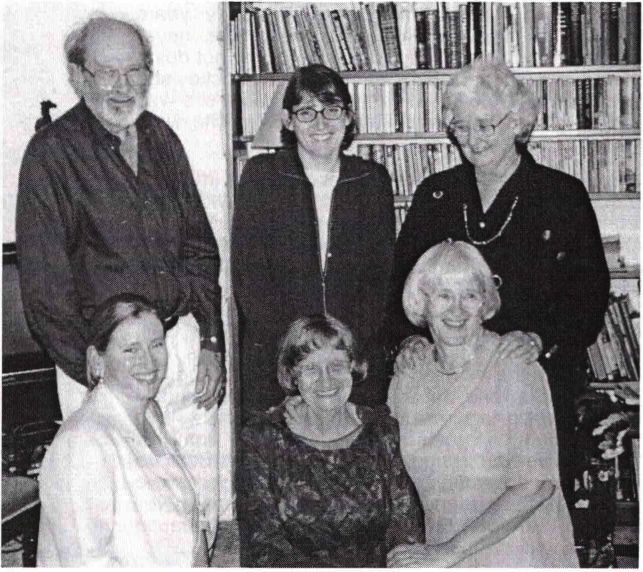
Some of the Dickins Family, 1999. Left to right, back: Neil Dickins, Lisa Worrall, Marie Nemec. Front: Jessica Worrall, Joy Stewart, Margaret Worrall. On the occasion of Joy's Retrospective Exhibition.
While living in Brisbane, Marie again had trouble with asthma and she and George decided that when George retired they should remain in the tropics as this seemed to suit Marie better. They made plans for retiring to Cairns. Unfortunately, before they could do so, George was diagnosed with cancer of the pancreas and died in July 1979. Marie decided to proceed as they had planned and she moved to Cairns in 1980.
Marie completed her accountancy exams in 1976 and after the move to Cairns she obtained work in this profession. Wanting permanent part-time work, as she had had in Darwin and which she found hard to obtain in Cairns, Marie decided to set up her own practice in 1981, working from home with seven clients. She found she had to overcome a certain amount of prejudice because she was a woman. The practice flourished and two years later she opened an office away from the house. In 1990 she went ‘electronic’ for lodgements with the Taxation Office. Marie was registered as a Local Government Auditor and did audits for a number of
page 196
shires in North Queensland between 1983 and 1994. This gave her an opportunity to visit some of the remoter parts of the State.
As a member of the Australian Society of Certified Practicing Accountants, Marie took an active part in that organization’s activities, serving as branch Treasurer, Secretary and President. She also taught accountancy students at the Cairns Business College. Marie sold her practice in 1994 with the intention of retiring. However, other accountants kept offering her work, so she continued working on a part time basis until 1998.
Marie had been an active member of the National Trust for many years, undertaking research and conducting tours of the McLeod St Pioneers’ Cemetery in Cairns. She has been involved in the preparation of several publications dealing with the history of the Cairns region and she has written a book about those buried in the Pioneers’ Cemetery.25 In 2001 she received a Commonwealth Year of the Volunteer award for her cultural and heritage work. Marie is a keen gardener with a preference for orchids and bromeliads. She belongs to the Gardening Club, Cairns Historical Society, Friends of the Cairns Regional Gallery and participates in the University of the Third Age. One of the projects for her busy retirement is taking piano lessons.
Barbara Joan DICKINS (1931-1974) - married name WILLIAMS
Third daughter and fifth child of Charlotte Robertson and Sid Dickins, born at Geelong on 6 March 1931. Named after Barbara Crouch whom Lottie had lived with for a time when she was a child.

Barbara Dickins. Passport photo taken in 1957.
The doctor told Lottie not to get too fond of Barbara, which suggests the doctor did not expect her to survive. She did survive, though she experienced frequent illness during childhood and was to die at the age of forty-three. She was small (just under five feet), pale skinned and dark haired, taking after the Cairns side of the family rather than the Robertson side. She was born with brown eyes. She had a fiery temper but this cooled down as fast as it heated up and she never held a grudge.
Because of illness Barbara started school a year late. She attended Ruyton Girls Grammar School and missed further time during the early years because of illness. However, illness was never allowed to be an excuse for missing out or not doing things, and when Barbara wanted to play hockey she was allowed to do so, even though it meant she was sometimes so tired when she got home, she went straight off to bed.
Moving to the Methodist Ladies College in 1947, Barbara obtained her Leaving Certificate two years later. Her first job after leaving school was selling encyclopaedia. At the Alfred Hospital in Melbourne she trained as a nursing sister (1951-53) and then went on to work at the Mornington District Hospital. In 1956 she was working in Adelaide for a doctors’ clinic and sharing a house with her brother Neil. Barbara was very much a night owl and always hard to get up in the morning. Neil tells of her having two alarm clocks, one put in a drawer, so she actually had to get up to turn it off. She would often sleep through both of the alarms. Another story from this time involved a missing dinner plate, which Barbara was worried about because she and Neil were housesitting for friends who were overseas. Neil had put the plate on top of the fridge but because Barbara was so short she could not see it.
The next year saw Barbara off to Europe, where she and some of her nursing friends worked and travelled. Their adventures in Spain were
page 197
documented by Mary Farrow who was little and fiery like Barbara. 26 Much to the consternation of the third member of the party (a Canadian girl), Barbara and Mary were always arguing. But this was just their way and never interfered with their friendship. Barbara’s dark looks led many Spaniards to believe she was a local, and along with her insistence that she could understand the language (which she couldn’t), resulted in some amusing incidents - including the ardour of a young Spanish swain, which Barbara did not appreciate. Her most memorable job in England was specialling ‘the General’, an aged retired army general of the traditional mould. Another job, shared with Mary, was looking after a Guest House in London. Barbara returned to Australia from Europe in July 1960.
Barbara used to get frustrated that because of her small stature, whenever she went to a party or social function, short men would make a beeline for her. She swore she would never marry anyone under six feet. However love makes other decisions and in 1961, Barbara met and married Graham WILLIAMS (1930- ) who is well under six feet. Graham was a widower with a two year old son. Barbara legally adopted Bruce, and the couple had two children together, Jennifer (1963) and Ian (1966), both by caesarean section.
Barbara and Graham moved from Melbourne to Mt Evelyn and as the children got bigger, Barbara did casual work for the local Home Help Service. She developed thyroid trouble and the doctors had difficulty adjusting her medication so that she swung back and forth between thin hyperactivity and plump depressed lethargy. On 28 October 1974 Barbara suffered a massive heart attack and Graham found her dead on the lounge room couch.
Barbara was a vivacious and gregarious person. She made friends wherever she went and though she often drove her family to frustration because of her lateness, quick temper and independent ways, her generosity of heart made up for her defects. A favourite story is about Barbara and Neil having an argument as children. Barbara threw a pair of scissors at Neil, he ducked, and the scissors went through a window. For years the blame for the broken window would be passed back and forth between them - Neil said it was Barbara’s fault for throwing the scissors and Barbara said it was Neil’s fault for ducking. The incident eventually turned into one of those family jokes, raised whenever families get together.
Graham remarried in 1977 to Mary Louise Jones (nee Smart - born 1935), a widow with two children, making a successful blended family for Barbara’s children. 27
Margaret Dawne DICKINS (1934- ) - married name WORRALL
Sixth child and fourth daughter of Charlotte Robertson and Sid Dickins, born at Geelong on 27 February 1934. Margaret is a common family name and Dawne came from the fact that she was born at dawn.
Margaret’s birth took place a matter of days after the family moved from Geelong to an old house on the Esplanade at North Shore. Unlike most of Lottie’s other children, who had been born at home, Margaret was born in hospital because she was a breech birth. Despite being only three years old when the family left the house at North Shore, Margaret has a clear memory of the house, the beach across the road and the gate to the cow paddock at the back, and had no difficulty identifying the house years later when she went looking for it.
Margaret’s primary education was undertaken at Ruyton Girls Grammar School. Two senior students who lived near by were charged with escorting Barbara and Margaret to school and home again. Margaret has a pair of beautifully illustrated fairy stories one of these girls created for her.
For her secondary schooling Margaret moved to the Methodist Ladies College in Kew, which like Ruyton, was in easy walking distance of home. School was not a happy experience and secondary school was a real struggle. Several years had to be repeated and Margaret finally matriculated only because of the faith and persistence of her mother. Lottie was always willing to do battle for her children and at different times on behalf of different children, there were disagreements with school authorities about her children’s intelligence and ability.
page 198
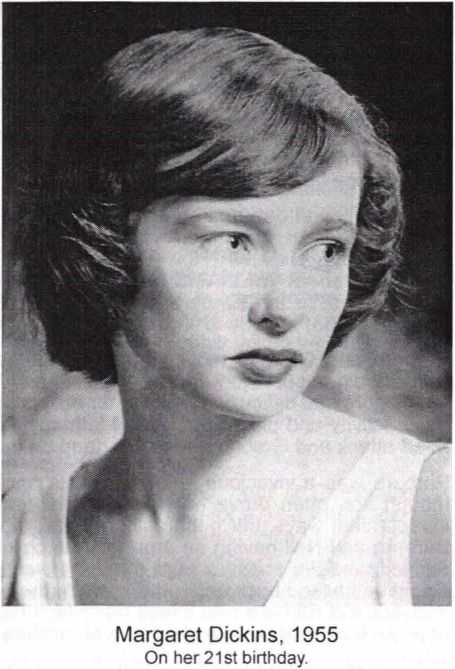
Moving on to Melbourne University, Margaret studied for the Diploma of Social Studies and a new and exciting world opened up. Study suddenly became less difficult and in her second year she was granted a Commonwealth Scholarship. This included a living allowance of £3 a week: “£1 went to Mum for board, £1 went on fares, and that left £1 for everything else! I used to do a lot of walking to save on fares and I only bought two text books the whole time I was at Uni, the rest of the time I used the Library.” Extra curricular and social activities, along with work experience and holiday jobs, broadened her horizons and went some way to giving her a confidence she had previously lacked. Margaret’s first employment as a social worker was with the Brotherhood of St Laurence in Fitzroy, where she worked for two years with a small number of families who had been rejected for re-housing by the Victorian Housing Commission.
In February 1957 Margaret married John WORRALL (1933- ) at the Barker’s Rd Methodist Church, Kew, Victoria straight across the road from the Dickins’ house. John is the older child and only son of Erlwell Worrall and Maisie Abbott. The couple met through the social activities of the MHSOB’s lacrosse club (see biography on Neil) and their friendship continued during their time at university. At the time of their marriage Margaret was working but John was still studying for his Electrical Engineering degree, and when Margaret became pregnant with their first child she kept right on working until she was seven months pregnant. John completed his course and started full time work only a few weeks before the birth of Lisa in 1958. Two other daughters followed, Tracy, born in Nauru (1959) and Jessica, born in Cairns (1963).
Margaret and John were keen to travel overseas. John obtained a position with the British Phosphate Company in Nauru, just south of the equator, and the family lived there for nearly two years. Returning to Australia, they decided there was no way they could live in crowded cold Melbourne, so John applied for and obtained a position with the Electricity Board in Cairns, North Queensland. After three years in Cairns the next move was to Western Samoa and this proved an exceptionally happy and rewarding experience. However it seemed advisable to return to Australia for the children’s education, so it was back to Cairns in 1967 and then a move to Innisfail six months later. In the first grade in Samoa when daughter Tracy was learning to read, the children used second-hand books donated by countries such as Australia and New Zealand. Half the class had ‘Dick and Dora’ and the other half had ‘Jack and Jill’. Ironically it turned out that Lisa and Tracy were well ahead of their contemporaries when they came back to an Australian school.
Like the rest of her family, Margaret became involved in community activities wherever she lived - School P&C associations, youth groups, welfare and cultural organizations, (too many to list). Her experience during an extended stay in the Innisfail hospital in 1973 convinced her that she must get back into professional social work. Added to this was sister Barbara’s death the following year. “Barbara was my dearest friend and her death was the biggest trauma I had experienced in life. I felt a need to live two lives - one for myself and one for Barbara.”
Margaret became involved in setting up a Community Advice and Information Centre in Innisfail, where welfare facilities were extremely limited. She acted as honorary co-ordinator and counsellor, and trained voluntary workers. In addition she undertook fee-for-service work for the Department of Social Security and other welfare organizations without a representative in Innisfail. For many years she was the only practicing professional social worker between Cairns and Townsville and her caseload included anything and everything that turned up on her doorstep. In Dec/Jan 1978/79 Margaret made a trip to China with a group of welfare workers.
Following Margaret and John’s separation in 1979 Margaret spent an unsettled period, travelling around Australia with her possessions in her car and getting work as and where she could. This
page 199
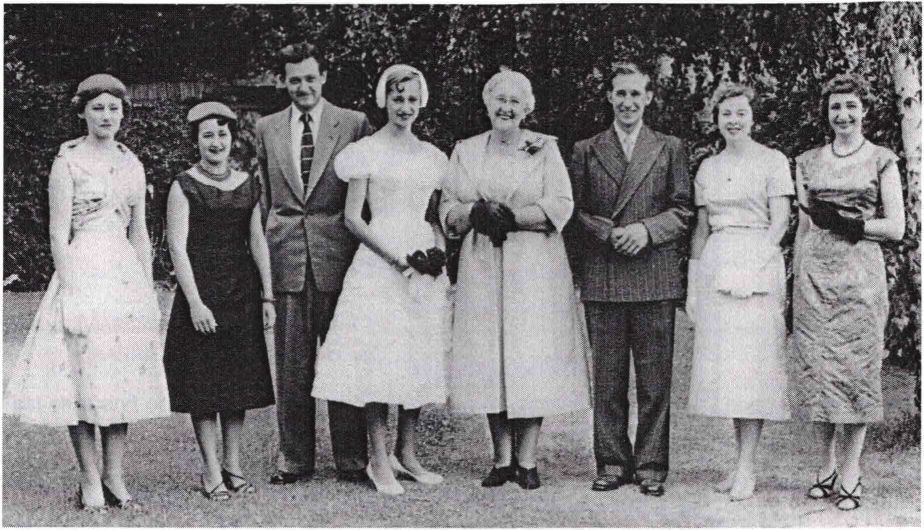
Dickins Family, 1957. At Margaret's wedding from left to right Marie, Barbara, Neil, Margaret, Lottie, Mac and his wife Gwen, Joy.
included work as a housekeeper and cook as well as personal and financial counselling jobs with the Smith Family and the Catholic Family Welfare Bureau in Canberra. Needing to settle down again Margaret returned to Innisfail in 1983 and was employed by the CAIC as a Grant-in-Aid worker with newly arrived and long term migrants living in the Mulgrave, Johnstone and Cardwell Shires. Her employment as a social worker in various capacities continued until her retirement in 1994 when she was made a life member of the CAIC (now called the Community Support Centre). As a member of the Australian Association of Social Workers, Margaret was the field practitioners’ representative and vice-chairperson on the Board of Studies in Social Work at James Cook University from 1985 to 1988.
Retirement did not mean the end of Margaret’s involvement in welfare and community affairs. Training and mentoring professional and voluntary welfare workers have been a continuing activity. For three years Margaret served on the Qld Older Australians’ Advisory Council, an advisory body to the Commonwealth Minister responsible for Aged Care Programs. In 1998 Margaret received a Commonwealth Year of Older Person’s award for work in establishing local services for the victims of domestic violence. She is currently a member of the State committee responsible for allocating the Queensland Premier’s Awards for Seniors.
Margaret has inherited the family skill with sewing, knitting and handicrafts. She writes poetry and stories for family and friends and is a keen if somewhat erratic gardener. However her main interest throughout her life has always been people, people, people - with all their mysterious ways and guises. Margaret still lives in Innisfail and is responsible for chasing up family connections and stories about her Robertson relations. “Life is full of ups and downs, but on the whole it is pretty fantastic”.
1 Sid divorced Lottie in 1943. His marriage to Lottie's niece caused a long lastly split in the Robert Robertson family. See Lottie's biography in Chapter 18.
2 Henry Volk was the lacrosse coach at Melbourne University in the 1950s when my husband, John Worrall was captain of the University lacrosse team. So I also knew Henry Volk.
3 Henry Volk was the lacrosse coach at Melbourne University in the 1950s when the my husband, John Worrall was captain of the University lacrosse team. So I also knew Henry Volk.
4 Interview with Stuart Robertson, March 2000
5 Interview with Bob and Mary Robertson at Yass, March, 2000
6 Interview with Bob and Mary Robertson, March 2000
7 The two tapes are available to the public on-line - http//203.20.62.215/education/rr.htm. I hold copies of the Yass Tribune article mentioned above, Rutherford's entry for the 17th edition of ‘Who’s Who in the World', an article about him printed in the 1996 Annual Report of the Cambridge Australia Trust, and copies of obituaries published in several newspapers.
8 Information about Ian's life comes from his brother Rod and the records of his RAAF service.
9 Letter from Rod Robertson, 25 10.2002
12 Interview with Pixie Robertson, March 2000
13 Interview with Pixie Robertson, March 2000
14 Telephone conversation with Rod Robertson followed up by a letter, September 2002
15 Taped interview with Rod, Lucy and Pixie Robertson, March 2000
16 Mr Bennett was a long-term associate of the Robertsons and had known them in Geelong,
17 Interview with Rod and Lucy Robertson, March 2000
18 Letter from Rod Robertson, 25.10.2002
19 Matthew Magilton is also a member of the MG Club
20 The following account of Locky’s life has been pieced together from his wife’s eulogy, written by son Bill, which was provided by Bill Robertson in July 1999. Quotations are taken from the Eulogy. Unfortunately I have lost contact with Bill and have not been able to have him check what I have written.
21 A fuller description of Joy’s life and work is contained in M. Muecke, ‘Done By Me - The Art and Memoirs of Joy Stewart’, published in Cairns for her retrospective exhibition at the Cairns Regional Gallery in 1999
22 M. Muecke, 'Done By Me - The Art and Memoirs of Joy Stewart', p.29
23 ‘The Border Watch’, 11 January 2000, p.9
24 M Nemec, November 2000
25 M. Nemec, ‘A Walk Through the McLeod St Cemetery', Self published, Cairns, 2002
26 M. Farrow, ‘Spanish Interlude'
27 Mary’s first husband was Ron Jones and they had two adopted children, Anthony Peter -b. 31.12.1962, and Julie Marianne - b. 8.8.1964. After Mary’s marriage to Graeme both Tony and Marianne took the name Williams.
Garry Gillard | New: 27 March, 2019 | Now: 5 September, 2022